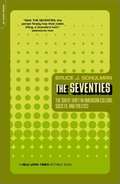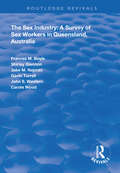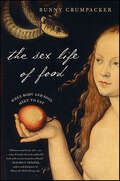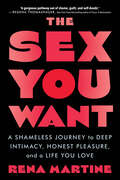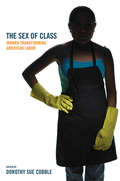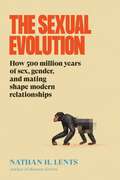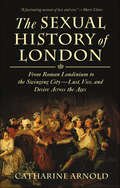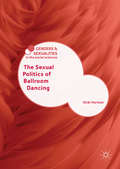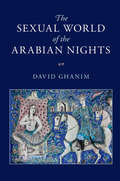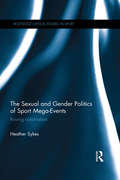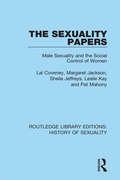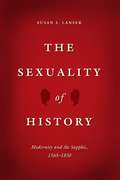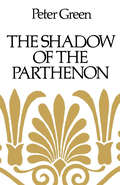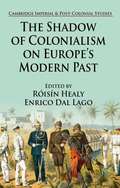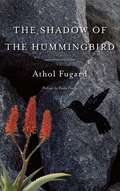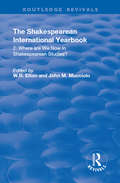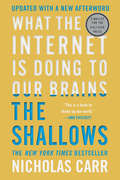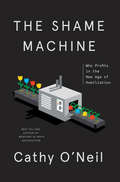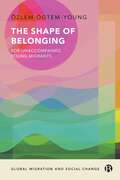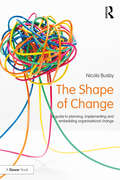- Table View
- List View
The Seventies: The Great Shift in American Culture, Society, and Politics
by Bruce J. SchulmanSweeping away misconceptions about the "Me Decade, " Schulman offers a fast-paced, wide-ranging, and brilliant examination of the political, cultural, social, and religious upheavals of the 1970's.
The Sex Industry: A Survey of Sex Workers in Queensland, Australia (Routledge Revivals)
by John S. Western Frances Boyle Shirley Glennon Jake M. Najman Gavin Turrell Carole WoodFirst published in 1997, this study reports on a study of 221 sex workers in Queensland, Australia. The workers were interviewed by an interviewer with experience in the industry. They were asked a variety of questions relating to how they came to enter the industry, their knowledge of and attitudes towards safe sex, and a variety of other questions to do with lifestyle, service use and sexual health, and contact with the police and legal system. Sex work emerges as an activity which has a number of advantages. The pay is good, the hours are short and the work enables the worker to meet some interesting people and engage in social activities. Unlike other occupations, entry into sex work is somewhat haphazard (few appearing to plan entry to this industry as a career path) but, once in the industry many find it has benefits as well as disadvantages. Primary amongst these latter are the risks of acquiring a sexually transmitted disease (AIDS being uppermost in their minds) or the fear of violence which is associated with the context in which services are provided. In addition, sex workers often manifest a lifestyle which includes substance use and abuse. Relationships with police are often problematic and many workers report experiences which are critical of the legal system. This book provides a broad insight into the industry which, for parts of Australia, is subjected to substantial change. Such insights contribute not only to our understanding of the industry itself but also to the kind of health promoting activities which need to be initiated.
The Sex Life of Food: When Body and Soul Meet to Eat
by Bunny Crumpacker"The sex life of food" doesn't mean that the strawberries have fallen in love with the oatmeal. It's a look at food—and sex—and how they go together in our daily lives much more often than we realize. There are so many ways that hunger and desire act on each other, and so many things that can influence our preferences. Not only are people moved by the taste, texture, and the shapes of the food they eat, but even the names of some dishes can kindle hunger—of both kinds—in some. As the author writes, "Sometimes cooking is foreplay, eating is making love, and doing the dishes is the morning after."The many things Bunny Crumpacker shares with the readers of her fascinating book almost could have inspired her to write a novel, sending Adam and Eve (with their apple) traveling through history as the icons of our passions. Instead, she has gone far beyond the obvious to bring us unexpected and tantalizing knowledge of how much and in how many surprising ways we assuage our hunger for both food and sex and how where there's one, there is often the other. The result is a continued delight. There's history and humor, obvious connections and truly amazing ones. The author enlightens us on a myriad of topics, including food in fairy tales, what politicians eat, comfort food, and manners at the table.But enough! There's too much to say. Turn the pages and let Bunny Crumpacker introduce you to The Sex Life of Food.
The Sex Life of the Foot and Shoe (Routledge Revivals)
by William A. RossiFirst published in 1977, The Sex Life of the Foot and Shoe examines the realities of foot and shoe eroticism practised by almost all of us, whether consciously or unconsciously. Provocative often witty and always original, the book takes us on a walking tour through history: from Chinese footbinding (completely sexual in intent) and the medieval poulaine (perhaps the most blatantly pornographic shoe ever worn) to the outrageous distortions of the foot gladly suffered by woman over the centuries in the cause of sexual allure. The author explores the obsession with ‘sick’ and ‘tired’ feet and the huge industry that has sprung up to cater to our negativism. He gives a psychosexual guide to us via footwear, grouping men’s and women’s shoes into such categories as sexy, sexless, neuter, bisexual, sensuous, peacock, masculine, eunuch and machismo. This book will be of interest to students of history, gender studies, sexuality studies and fashion.
The Sex Role System: Psychological and Sociological Perspectives (Routledge Revivals)
by Jane Chetwynd Oonagh HartnettFirst published in 1978, The Sex Role System traces the phenomenon of sex role stereotyping through many different disciplines and areas of study, showing how presuppositions about sex role expectations can colour our perceptions and radically affect both the theories and the practices underlying our lives today. The contributions, by several well-known psychologists and sociologists, highlight many specific areas of stereotyping in our society, including marriage, school, work, psychiatry, the Social Security services, and the Inland Revenue.In drawing together the many facets of sex role stereotyping, the editors are able to show how the complex conscious and unconscious processes making up the System are formed. An empirical approach to the problems involved, together with a discussion of the ethical issues, ensures that the reader will gain a greater understanding of the System and its substantial influences during the course of the analysis. This book is a must read for students and researchers of psychology, sociology, and feminist studies.
The Sex You Want: A Shameless Journey to Deep Intimacy, Honest Pleasure, and a Life You Love
by Rena MartineYou Deserve Great SexWhen it comes to relationships, our society has plenty of expectations. We're supposed to know how to speak up for ourselves in bed, be caring partners, and, of course, love ourselves first. But no one tells us how to actually do all those things, and we are left feeling unsatisfied, confused, and ashamed when we don't measure up.Former Deputy District Attorney Rena Martine was in that position. After rejecting the ideal white-picket fence life, she embarked on a journey to redefine intimacy in a way that felt true. In the years that followed, Rena defied all of society's sexual norms, built a presence as a global women's intimacy coach, and created the intimate life she craved.Now she brings those experiences to you! With no-holds-barred honesty, stories from real-life women, and sparkling humor, THE SEX YOU WANT will help you:Build a secure relationship with your most important partner—YOURSELFGet in touch with YOUR expectations for relationships so you can date more intentionallyDemystify lifestyle practices outside of the heterosexual-monogamous-vanilla box with frank discussions of female sexual fluidity, kink, and ethical non-monogamyFind apps, products, and communities to satisfy any curiosityBring deep intimacy and exciting variety into your bedroom and beyondWhen it comes to intimacy, vulnerability, and connection, you'll find that no two women are alike. THE SEX YOU WANT replaces cookie-cutter advice with powerful self-discovery tools to help you make friends with your own confidence and curiosity, build rock-solid relationships, and embrace what YOU love!
The Sex of Class: Women Transforming American Labor
by Dorothy Sue CobbleWomen now comprise the majority of the working class. Yet this fundamental transformation has gone largely unnoticed. This book is about how the sex of workers matters in understanding the jobs they do, the problems they face at work, and the new labor movements they are creating in the United States and globally. In The Sex of Class, twenty prominent scholars, labor leaders, and policy analysts look at the implication of this "sexual revolution" for labor policy and practice. The Sex of Class introduces readers to some of the most vibrant and forward-thinking social movements of our era: the clerical worker protests of the 1970s; the emergence of gay rights on the auto shop floor; the upsurge of union organizing in service jobs; worker centers and community unions of immigrant women; successful campaigns for paid family leave and work redesign; and innovative labor NGOs, cross-border alliances, and global labor federations. Revealing the animating ideas and the innovative strategies put into practice by the female leaders of the twenty-first-century social justice movement, the contributors to this book offer new ideas for how government can help reduce class and sex inequalities. They assess the status of women and sexual minorities within the traditional labor movement and they provide inspiring case studies of how women workers and their allies are inventing new forms of worker representation and power.
The Sexual Evolution: How 500 Million Years of Sex, Gender, and Mating Shape Modern Relationships
by Nathan H. Lents“Enthralling . . . Lents gleefully tears down cis, hetero, and monogamous norms, outlining surprising case studies that give the lie to restrictive conceptions of gender and sex. The result is an indispensable glimpse into the queerness of animals.” — Publishers Weekly (starred review)Evolutionary biologist Nathan H. Lents knows what makes humans unique—and it’s most definitely not our sexual diversity. A professor at John Jay College, Lents has spent his career studying what makes us, well, us, and contrary to what the culture warriors want people to believe—diverse sexual behavior is not a new development, or even a human one. It didn’t just emerge from a progressive culture; it’s the product of billions of years of evolutionary experimentation throughout the animal kingdom. It’s not a modern story, a Florida story, or even a human story. It’s a biological story.In The Sexual Evolution, Lents takes readers on a journey through the animal world, from insects to apes, revealing what the incredible array of sexual diversity can teach us about our own diverse beauty. Nature, it turns out, has made a lot of space for diverse genders and sexual behaviors. And why? Because when it comes to evolution—diversity wins. This is not just a political or social message, instead it’s rooted in science and cultivated from understanding the full breadth of sexuality that exists throughout the world.With shades of both Frans de Waal and Esther Perel, Lents’s storytelling is as fascinating as it is topical, offering eye-opening stories about the diversity of animal life, while relating it to our own sexual journey as a species. At once a forceful rebuttal to bigotry and a captivating dive into the secret sex lives of animals, The Sexual Evolution is the rare book of pop science that leans into the controversy. Sex, the reactionaries say, should only be for procreation between a man and a woman, anything else goes against nature. Well, nature would like a word with them.
The Sexual History of London: From Roman Londinium to the Swinging City—Lust, Vice, and Desire Across the Ages
by Catharine ArnoldIf Paris is the city of love, then London is the city of lust. From the bath houses of Roman Londinium to the sexual underground of the twentieth century and beyond, The Sexual History of London is an entertaining, vibrant chronicle of London and sex through the ages.For more than a thousand years, England's capital has been associated with desire, avarice, and the sins of the flesh. Richard of Devises, a monk writing in 1180, warned that "every quarter abounds in great obscenities." As early as the second century AD, London was notorious for its raucous festivities and disorderly houses, and throughout the centuries the bawdy side of life has taken easy root and flourished. In The Sexual History of London, award-winning popular historian Catharine Arnold turns her gaze to London's relationship with vice through the ages. London has always traded in the currency of sex. Whether pornographic publishers on Fleet Street, or courtesans parading in Haymarket, its streets have long been witness to colorful sexual behavior. In an accessible, entertaining style, Arnold takes us on a journey through the fleshpots of London from earliest times to present day. Here are buxom strumpets, louche aristocrats, popinjay politicians, and Victorian flagellants—all vying for their place in London's league of licentiousness. From sexual exuberance to moral panic, the city has seen the pendulum swing from Puritanism to hedonism and back again. With latter chapters looking at Victorian London and the sexual underground of the twentieth century and beyond, this is a fascinating and vibrant chronicle of London at its most raw and ribald.
The Sexual Politics of Ballroom Dancing (Genders and Sexualities in the Social Sciences)
by Vicki HarmanThis book presents an engaging sociological investigation into how gender is negotiated and performed in ballroom and Latin dancing that draws on extensive ethnographic research, as well as the author’s own experience as a dancer. It explores the key factors underpinning the popularity of this leisure activity and highlights what this reveals more broadly about the nature of gender roles at the current time. The author begins with an overview of its rich social history and shifting class status, establishing the context within which contemporary masculinities and femininities in this community are explored. Real and imagined gendered traditions are examined across a range of dancer experiences that follows the trajectory of a typical learner: from finding a partner, attending lessons and forming networks, through to taking part in competitions. The analysis of these narratives creates a nuanced picture of a dance culture that is empowering, yet also highly consumerist and image-conscious; a highly ritualised set of practices that both reinstate and transgress gender roles. This innovative contribution to the feminist leisure literature will appeal to students and scholars of anthropology, dance, sport, gender, cultural and media studies.
The Sexual World of the Arabian Nights
by David GhanimFrom the stories of wives and their lovers to those of kings and their conquests, to the overarching story of Shahrazad and Shahryar, the tales of the Arabian Nights have offered countless audiences entertainment and enjoyment as well as serving as cautionary stories.<P><P> An outstanding piece of world literature, the Arabian Nights provide a lively and interesting way of exploring aspects of sexuality, romance, gender, culture, wealth, and politics. Looking at a wide range of the tales, David Ghanim offers a rigorous exploration of their profound sexuality: looking at both the context in which they were written and organised, as well as their legacy. By including accounts of heterosexuality, homosexuality, cuckoldry, insatiable lust, promiscuity, rape, incest, bestiality, demonic sexuality, and erotica, Ghanim highlights the complexity and dynamism of medieval sexuality, the active role of women in sexual activities, and the prevailing positive outlook on sexual liaison and gender mixing.<P> A systematic mapping of sexuality in the Arabian Nights, which provides a stark contrast to the sexual restrictions and taboos engulfing the Middle East today.<P> Highlights the value of these tales to the field of gender and sexuality studies.<P> Appeals to a wide readership by achieving an ideal balance between academic analysis and general description.
The Sexual and Gender Politics of Sport Mega-Events: Roving Colonialism (Routledge Critical Studies in Sport)
by Heather SykesThis challenging new study examines gender and sexuality in relation to the ‘roving colonialism’ of sport mega-events. Built around four case studies in postcolonial and settler colonial contexts—the Olympics in Vancouver, London and Sochi and soccer fans in the Egyptian revolution—the book examines sporting 'homonationalism' and anti-colonial resistance. The first part discusses different moments of ‘homonationalism’ in sport. The second part explores how indigenous and anti-colonial protests against mega-sport events lead to different views about gender and sexuality politics in sport. It offers a critical counter-narrative to the view that gay and lesbian inclusion in global sporting events is simply a matter of universal human rights. The book calls for LGBT social movements in sport to move away from complicity with neoliberalism, nationalism and colonial-racial logics, particularly Islamophobia, toward a decolonial politics of solidarity. Theoretically sophisticated and empirically grounded, this book draws together important threads in the contemporary study of sport to illuminate the relationship between sport and wider society. It will be fascinating reading for any student or researcher interested in the sociology of sport, Olympic studies, gender and sexuality studies, postcolonial studies, indigenous studies, settler colonial studies or the politics of race and inclusion.
The Sexuality Papers: Male Sexuality and the Social Control of Women (Routledge Library Editions: History of Sexuality)
by Sheila Jeffreys Margaret Jackson Pat Mahony Lal Coveney Leslie KayOriginally published in 1984. The history of sex in the last 100 years has usually been written as a story of progress from repression to sexual liberation. This book argues that the reverse is true, demonstrating that the ‘sexual revolution’ came as a backlash to a women’s movement which challenged men’s sexual abuse and tried to reconstruct male sexuality in women’s interest. At first it looks at those groups at the turn of the twentieth century who campaigned to challenge prevailing ideas about sexual behaviour. It moves on to review the work of the most influential sexologists Ellis, Kinsey, Masters and Johnson, and then presents a critical analysis of the sex magazine Forum.
The Sexuality of History: Modernity and the Sapphic, 1565-1830
by Susan S. LanserThe period of reform, revolution, and reaction that characterized seventeenth- and eighteenth-century Europe also witnessed an intensified interest in lesbians. In scientific treatises and orientalist travelogues, in French court gossip and Dutch court records, in passionate verse, in the rising novel, and in cross-dressed flirtations on the English and Spanish stage, poets, playwrights, philosophers, and physicians were placing sapphic relations before the public eye. In The Sexuality of History, Susan S. Lanser shows how intimacies between women became harbingers of the modern, bringing the sapphic into the mainstream of some of the most significant events in Western Europe. Ideas about female same-sex relations became a focal point for intellectual and cultural contests between authority and liberty, power and difference, desire and duty, mobility and change, order and governance. Lanser explores the ways in which a historically specific interest in lesbians intersected with, and stimulated, systemic concerns that would seem to have little to do with sexuality. Departing from the prevailing trend of queer reading whereby scholars ferret out hidden content in "closeted” texts, Lanser situates overtly erotic representations within wider spheres of interest. The Sexuality of History shows that just as we can understand sexuality by studying the past, so too can we understand the past by studying sexuality.
The Shade of Swords: Jihad and the Conflict Between Islam and Christianity
by M. J. AkbarCenturies of dispute.
The Shadow Economy
by Friedrich Schneider Dominik H. EnsteEuropean and Australian economists share recent findings on the size and development of the shadow economies; the driving factors of the shadow economy; and its interaction with tax morale, government institutions, and corruption. Their topics include a first attempt at a public choice explanation for the size and development of the shadow economy in India, regional variations in the nature of the shadow economy as revealed in a survey of 27 European Union member states, representative survey data in Germany on who is working illicitly and why, a critical appraisal of existing evidence on the link between the intrinsic motivation to comply with tax law and actual compliance behavior, and a latent variables approach to the impact of institutions on the shadow economy and corruption. Annotation ©2012 Book News, Inc. , Portland, OR (booknews. com)
The Shadow Of The Parthenon
by Peter GreenA lively combination of scholarship and unorthodoxy makes these studies in ancient history and literature unusually rewarding. Few of the objects of conventional admiration gain much support from Peter Green (Pericles and the "democracy" of fifth-century Athens are treated to a very cool scrutiny) but he has a warm regard for the real virtues of antiquity and for those who spoke with "an individual voice. " The studies cover both history and literature, Greece and Rome. They range from the real nature of Athenian society to poets as diverse as Sappho and Juvenal, and all of them, without laboring any parallels, make the ancient world immediately relevant to our own. (There is, for example, a very perceptive essay on how classical history often becomes a vehicle for the historian's own political beliefs and fantasies of power. ) The student of classical history will find plenty in this book to enrich his own studies. The general reader will enjoy the vision of a classical world which differs radically from what he probably expects.
The Shadow of Colonialism on Europe’s Modern Past (Cambridge Imperial and Post-Colonial Studies Series)
by Róisín HealyThrough a range of case studies from eastern and western Europe, this book breaks new ground in investigating the extent to which European peoples living within Europe were also subjected to the ideologies and practices of colonialism.
The Shadow of the Hummingbird
by Athol Fugard Paula Fourie"The greatest active playwright in the English-speaking world."--Time"If there is a more urgent and indispensable playwright in world theater than South Africa's Athol Fugard, I don't know who it could be."--Newsweek"Athol Fugard can say more with a single line than most playwrights convey in an entire script."--VarietyLegendary theatre artist Athol Fugard returns to the stage for the first time in fifteen years in this, his latest work. The Shadow of the Hummingbird tells the story of an ailing man in his eighties and the afternoon spent with his ten year-old grandson. In a charming meditation on the beauty and transience of the world around us, Fugard continues to mine the depths of the human spirit with profound empathy and heart. The text of the play includes an introductory Prelude by Paula Fourie with extracts from Fugard's unpublished notebooks.Athol Fugard has been working in the theater as a playwright, director, and actor for more than fifty years. In 2011, he received a Special Tony Award for Lifetime Achievement in the Theatre, and he was the inaugural Humanitas Visiting Professor of Drama at Oxford University. His plays include Blood Knot, Boesman and Lena, Statements After an Arrest Under the Immorality Act, Sizwe Banzi Is Dead, 'Master Harold' . . . and the Boys, The Road to Mecca, My Children! My Africa! and The Blue Iris.
The Shakespearean International Yearbook: Reparative Shakespeare (The Shakespearean International Yearbook)
by Alexa Alice Joubin Natalia KhomenkoIn the modern world, references to Shakespeare frequently mark moments of catastrophe and of the accompanying longing for restoring social order, remedying injuries, and building strong communities. Shakespeare’s moral authority has often been invoked to support artistic projects that claimed social justice as their goal on the assumption that drama has the power to manipulate perceptual reality. Drawing on cases from around the world, this book interrogates the idea that performing or reading Shakespeare has socially reparative value. It also acknowledges Shakespeare as a potential source of social well-being practices in the arts. The global framework shows that it is problematic to view Shakespeare as an impartial moral center.This book proposes that reparative creativity, or remedial uses of the canon, can give artists and audiences more agency. Having a map of canonical texts’ hidden ideologies can help readers, artists, and playgoers navigate its landscape, which is in itself a reparative act.
The Shakespearean International Yearbook: Volume 2 (Routledge Revivals #3)
by John M. Mucciolo W. R. EltonThis title was first published in 2002. This second volume of The Shakespearean International Yearbook continues the work of assessing the present state of Shakespeare studies in the new millennium. Comprising 20 essays by distinguished scholars from North America, the UK and Australia, it is divided into sections on criticism and theory; text, textuality and technology; Renaissance ideas and conventions; and Shakespeare and the city. The essays address issues that are fundamental to our interpretive encounter with Shakespeare, including those of gender and sexuality, the staging of plays, and historical research on matters such as the monarchy, language, religion, and the law.
The Shallows: What The Internet Is Doing To Our Brains
by Nicholas CarrNew York Times bestseller • Finalist for the Pulitzer Prize “This is a book to shake up the world.” —Ann Patchett Nicholas Carr’s bestseller The Shallows has become a foundational book in one of the most important debates of our time: As we enjoy the internet’s bounties, are we sacrificing our ability to read and think deeply? This 10th-anniversary edition includes a new afterword that brings the story up to date, with a deep examination of the cognitive and behavioral effects of smartphones and social media.
The Shame Machine: Who Profits in the New Age of Humiliation
by Cathy O'NeilA clear-eyed warning about the increasingly destructive influence of America&’s &“shame industrial complex&” in the age of social media and hyperpartisan politics—from the New York Times bestselling author of Weapons of Math Destruction&“O&’Neil reminds us that we must resist the urge to judge, belittle, and oversimplify, and instead allow always for complexity and lead always with empathy.&”—Dave Eggers, author of The EveryShame is a powerful and sometimes useful tool: When we publicly shame corrupt politicians, abusive celebrities, or predatory corporations, we reinforce values of fairness and justice. But as Cathy O&’Neil argues in this revelatory book, shaming has taken a new and dangerous turn. It is increasingly being weaponized—used as a way to shift responsibility for social problems from institutions to individuals. Shaming children for not being able to afford school lunches or adults for not being able to find work lets us off the hook as a society. After all, why pay higher taxes to fund programs for people who are fundamentally unworthy? O&’Neil explores the machinery behind all this shame, showing how governments, corporations, and the healthcare system capitalize on it. There are damning stories of rehab clinics, reentry programs, drug and diet companies, and social media platforms—all of which profit from &“punching down&” on the vulnerable. Woven throughout The Shame Machine is the story of O&’Neil&’s own struggle with body image and her recent weight-loss surgery, which awakened her to the systematic shaming of fat people seeking medical care.With clarity and nuance, O&’Neil dissects the relationship between shame and power. Whom does the system serve? Is it counter-productive to call out racists, misogynists, and vaccine skeptics? If so, when should someone be &“canceled&”? How do current incentive structures perpetuate the shaming cycle? And, most important, how can we all fight back?
The Shape of Belonging for Unaccompanied Young Migrants (Global Migration and Social Change)
by Özlem Ögtem-YoungUnaccompanied children and adolescents seeking protection in the UK are among the most vulnerable migrant groups, and often find themselves in a hostile policy environment after enduring traumatic journeys. This book offers an in-depth analysis of the lived experiences of belonging, and the politics and policies of migration. Focusing on unaccompanied young migrants, it investigates the conditions and nature of belonging in the face of the uncertainty, ambiguity and violence of the UK asylum system. Drawing on interviews and the Deleuzo-Guattarian concepts of assemblage, the book provides an empirical and theoretical examination of the belonging of unaccompanied young migrants seeking protection in the UK. Through compelling accounts, the author portrays the complex and paradoxical nature of belonging under precarious conditions, shedding light on the tenacity and fragility of belonging for unaccompanied young migrants.
The Shape of Change: A guide to planning, implementing and embedding organisational change
by Nicola BusbyNo organisations, change initiative or stakeholder is ever the same. The way business change management is shaped to work with and get the best out of every different change situation makes a vital contribution to the success of the change. The Shape of Change is the first business change management book to focus solely on the practical challenges of how to plan, implement and embed successful business change initiatives in a wide range of organisations from the business change manager’s point of view. It focuses on shaping every different change approach to take into consideration each individual situation including organisational culture, the type and impact of change the initiative, the attitudes and concerns of stakeholders and the potential for resistance within the organisation. Using a series of example change initiatives in private, public and non-profit sectors, it describes the change management journey, highlighting key points where business change management interventions are essential, and exploring how it feels to undertake business change initiatives in a wide range of situations, from communicating the initial change idea to ensuring the change is embedded and working well in business as usual. Accessible and comprehensive, The Shape of Change is relevant to anyone working in or planning organisational change.
